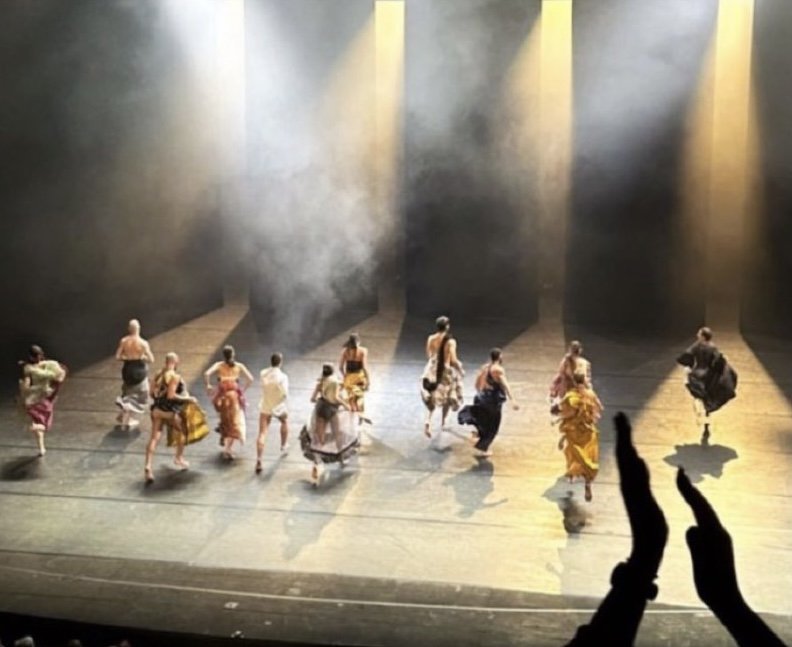Creating movement material is usually the first, yet not the most important step in the work. Studying it, selecting, and understanding how this material will be used in the context of choreographic constellations, is where I feel the work happens.
Effects
Visual effects of all sorts (including the choreographic ones), are a very boring strategy to cover up a poor and lacking choreographic structure.
Mechanics
Getting the full potential out of a movement, has to do with finding the right balance between cadence/rhythm/speed, and amplitude/breadth/range.
Simple
Art that is overly complicated, is usually the result of anxiety emanating from the artist not really mastering his/her process (or not having one in the first place). Being in touch with a genuine artistic process, has a tendency to calm the maker down and simplify things.
Hmm…
There’s a fine balance to be found between understanding the process analytically, while at the same time not fully understanding all aspects of it. Some aspects of the creative process, are better left outside the maker’s analytical perception of the whole. Some tools become fully effective, only under the condition that they are not fully understood and named.
Tour guide
My works are always choreographed by the dancers. What I do, is give them the guidance they each seek.
Symbolism
Working with symbolism as a choreographic strategy, deprives dance from its deepest potential.
Scale
Good choreography is somehow always larger than the stage it’s being performed on.
Amnesia
Tools, processes, strategies and all other elements related to the process, should always be slightly forgotten over time, in order to allow constant change, reevaluation and the regeneration of new ways and approaches. Amnesia is a necesery tool in making room for new ideas.
Teaching dancers
I don't teach dance students to dance, I try to teach them to think choreographically. I'm less interested in teaching them how to move, but rather get them to think why and how they're moving.
Statement/observation
Good work is not about making a statement - it’s an observation.
Expectations and drawers
I enjoy being where I'm not expected, taking roads I'm not supposed to, jumping above and below where people think I'm at. It keeps my artistic feet grounded.
The result though, is that almost no one has a full image and understanding of the work as a whole.
Politics
There's a certain point, which beyond it, an artist which engages in the political power games of his own artistic field, is actually revealing the irrelevance of his art.
Cynicism
A valuable piece of art - or better, a meaningful artistic action, cannot be cynical. The two don’t mix well.
Doing
Choreography is about DOING. It’s about actions in the context of the choreographic thing.
A choreographic vision for dancers
It’s the understanding of the choreographic context of a work, that gives dancers the ability to make sense of their actions. Dancers must be encouraged to have a choreographic vision of the work they are part of. The way to do that, is by carefully placing chunks of responsibility in their lap. To put them in situations where they must consider the choreographic whole and make it an integral part of their process. Most of them will resist (except for the ones with choreographic ambitions), but eventually most dancers will grow into that place, once they realise how good it feels to actually understand why you do something and how it is made.
Struggle/Effort
‘Struggle', and 'effort', are too radically different things. When one makes wrong decisions while devising his process and system, he will usually find himself struggling very fast, making the right decisions on the other hand, will not eliminate the need to make efforts, but at the same time, it will avoid producing a state of struggle.
Sets
My stage sets are made of sound and light.
Repertoire
Existing choreographic work (in the sense of 'repertoire') outside of the direct context and presence of it’s maker, Is an old concept. It doesn’t apply to the way contemporary dance is being made and thought of. Contemporary dance is everything the concept 'repertoire' isn't.
Movement
Choreography cannot exist without movement - movement not in the sense of dancers moving, but in the sense of a kinetic substance which is in constant movement. The fact it happens while time is moving forward, is not enough. The duration of a choreography is completely separate from its own movement through the 'theatrical time'. A constant sense of movement through that particular performative time, must be present. By the time it ends, a choreography should be at a completely different "place" than the one it started at. It has moved, on a totally different time plane than the passing of time.








